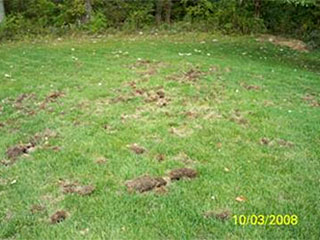Grub Control
 JT Services highly recommends grub control for all lawns. This insect can cause serious damage when a significant population occurs on a lawn or other turf area.
JT Services highly recommends grub control for all lawns. This insect can cause serious damage when a significant population occurs on a lawn or other turf area.Grubs feed on grass roots. Irregular shaped areas that are browning or wilting may be a sign of grubs. The best way to check for grub damage is to pull back the turf along the areas of the browning and look for the white, c-shaped grubs.
Other factors can cause browning of the turf, like poor root systems. Shaded grassy areas often have weak root systems that will get brown and pull up easily, but grubs will not likely be found in shaded areas.
The adult stage of a grub’s life cycle is a beetle. Adult beetles lay their eggs in full sun grassy areas with moist soil. Two common beetles in Central Ohio are European Masked Chafers, who lay eggs in May, and Japanese Beetles, who lay eggs in June.
JT Services applies grub control in May. It will last for 3 months to treat all of the grub larvae that might be laid by the beetle and chafer population common to our area.
If significant grub damage has already occurred, lawn repairs will need to be made in the early fall and may include aeration and over-seeding.
Grub Control is included in our Premium and Elite Fertilization Programs.
Click here for your free estimate
